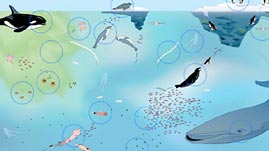Teachers' Domain - Digital Media for the Classroom and Professional Development
User: Preview

Source: Woods Hole Oceanographic Institution



In this interactive activity adapted from the Woods Hole Oceanographic Institution, learn about seasonal environmental conditions in the Antarctic and their influence on the southern polar ecosystem. Investigate the variety of organisms that inhabit this unique ecosystem during summer and winter. Additional information reveals how significant factors, including food supply and sea ice, respond to changing climate conditions.
Both the Arctic and Antarctic regions are characterized by dramatic seasonal variations that, in turn, determine the kinds of life that inhabit these regions. Due to the manner in which Earth orbits the Sun—that is, tilted on its axis—these polar regions experience long summer days with continuous or near-continuous daylight, and winter days dominated by darkness. When one pole is exposed to the Sun's warming light, the other is pitched mostly in bitter-cold darkness.
The Antarctic ecosystem is a product of its climate. Apart from lichens and a few species of tiny insects that live in isolated regions, researchers have found virtually no other life forms in the continent's interior. Even though summer brings relative warmth, temperatures remain well below freezing, so ice and snow cover persists year-round. In contrast, the Southern Ocean and the sea ice that surrounds Antarctica undergo important seasonal changes that provide a rich habitat for abundant marine life.
Sea ice, which extends from the land over the water like a blanket, ranges from its summertime area of about 4 million square kilometers (1.5 million square miles) to 20 million square kilometers (7.5 million square miles) in winter. Water becomes denser the saltier and colder it gets, so when sea ice forms in winter, the water beneath it sinks. This sinking water drives a deep-water current that moves toward the Equator. It is replaced by less-dense rising water that contains nutrients stirred up from the depths.
Simple models called food chains depict possible paths along which energy moves through an ecosystem—as from producer A to consumer B to consumer C. Because most consumers have more than one food source, a more complex model called a food web is used to show how the various food chains in an ecosystem are connected. At the base of the Antarctic food web are microscopic, single-celled plants called phytoplankton.
During the light-filled summer months, phytoplankton float freely in the water and grow through photosynthesis. Using water, carbon dioxide, and sunlight, they produce oxygen and energy, which can be passed on throughout the ecosystem. The dense phytoplankton population feeds some animals directly, including shrimp-like crustaceans called krill, and soft transparent animals called salps. The krill and salps are food for animals further up the food chain, including penguins, seals, and whales. In the dark and cold of winter, phytoplankton are trapped inside and at the bottom edge of the ice that forms on the sea surface, where they remain until the summer thaw. As a consequence, the overall food supply shrinks.
Scientists studying this ecosystem now recognize that Antarctica's abundant marine life is largely confined to the edge of the sea ice. For this reason, they are closely monitoring the impact of climate change on sea ice.
 Loading Standards
Loading Standards Teachers' Domain is proud to be a Pathways portal to the National Science Digital Library.
Teachers' Domain is proud to be a Pathways portal to the National Science Digital Library.
